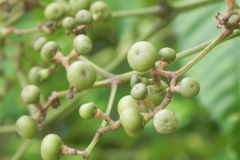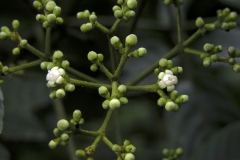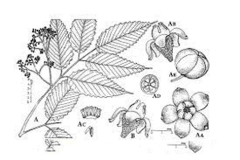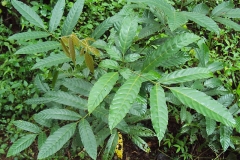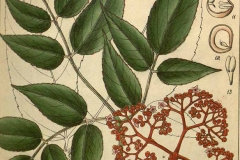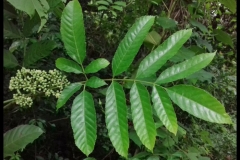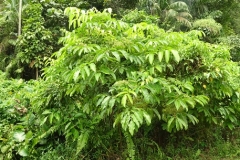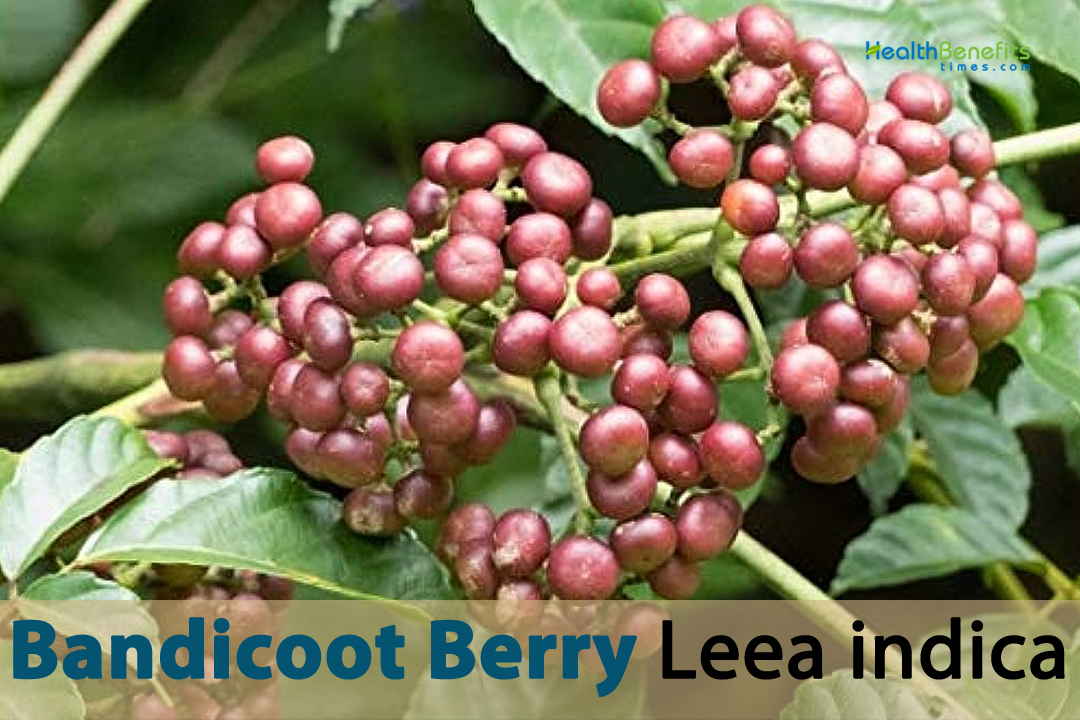 The formal name for Bandicoot Berry is Leea indica. It is a tropical plant that is part of the Leeaceae Dumort family. In different parts of the world, the plant is important for its cultural, culinary, and medical uses. The plant is native to Indo-Malaya, Indochina, the Western Ghats of India, and Sri Lanka, all of South-East Asia, northern Australia, the Solomon Islands, New Hebrides, and Fiji. Plants in Malesia, New Guinea, Australia, and the southwestern Pacific islands were once thought to be this species, but now they are thought to be a different species called Leea nova-guineensis. Some common names for the plants are White Indigo Berry, Wild Olive Berry, Manjakani Belimbing, White Berry Bush, White Coffee, Manjakani Berry, Black Berry, Coffee Plum, Coffee Randia, Wild Coffee, Wild Olive, Hairy Indigo Berry, Indian Blackberry, Coffee Plum Bush, Jungle Olive, Randia Fruit, Manja Fruit, Coffee Plum, Coffee Bush, White Olive, Wild Coffee Plum, White Randia, Indian Wild Coffee, Jungle Coffee and Indian Wild Indigo Berry.
The formal name for Bandicoot Berry is Leea indica. It is a tropical plant that is part of the Leeaceae Dumort family. In different parts of the world, the plant is important for its cultural, culinary, and medical uses. The plant is native to Indo-Malaya, Indochina, the Western Ghats of India, and Sri Lanka, all of South-East Asia, northern Australia, the Solomon Islands, New Hebrides, and Fiji. Plants in Malesia, New Guinea, Australia, and the southwestern Pacific islands were once thought to be this species, but now they are thought to be a different species called Leea nova-guineensis. Some common names for the plants are White Indigo Berry, Wild Olive Berry, Manjakani Belimbing, White Berry Bush, White Coffee, Manjakani Berry, Black Berry, Coffee Plum, Coffee Randia, Wild Coffee, Wild Olive, Hairy Indigo Berry, Indian Blackberry, Coffee Plum Bush, Jungle Olive, Randia Fruit, Manja Fruit, Coffee Plum, Coffee Bush, White Olive, Wild Coffee Plum, White Randia, Indian Wild Coffee, Jungle Coffee and Indian Wild Indigo Berry.
It is thought that the genus name “Leea” was named after James Lee, a Scottish gardener and nurseryman who lived in the 18th century. He was known for his work in gardening and the growing of plants. The word “indica” in the name of the species means “India,” which is a big place where Leea indica is often found. The word “indica” comes from the Latin word “indicus,” which means “of India” or “pertaining to India.” The plant is taken from the wild and used as food and medicine in the area. Local people in India and China grow it for medicinal reasons, as an ornamental plant, and as a green manure.
Bandicoot berry Facts
| Name | Bandicoot Berry |
|---|---|
| Scientific Name | Leea indica |
| Native | India, Sri Lanka, throughout South-East Asia, to northern Australia, Solomon Islands, New Hebrides and Fiji |
| Common Names | White Indigo Berry, Indian Blackberry, White Coffee, Manjakani Belimbing, White Berry Bush, Wild Coffee, Coffee Plum, Coffee Randia, Jungle Coffee, Wild Olive, Hairy Indigo Berry, Black Berry, Coffee Plum Bush, Randia Fruit, Wild Indigo Berry, Manjakani Berry, Coffee Plum, Coffee Bush, White Olive, Wild Coffee Plum, White Randia, Indian Olive, Coffee Berry, Indian Wild Coffee, Jungle Coffee Plum, Manja Fruit, Wild Olive Berry, Hairy Coffee Plum, Jungle Olive |
| Name in Other Languages | Arabic: Tut Bandikoot (توت بانديكوت), Tūt al-bāndīkūt (توت البانديكوت), lia hindia (ليا هندية) Assamese: Ahina (আহিনা), Kukura-thengia Bengali: Bandikoot Beri (ব্যান্ডিকুট বেরি), Byāṇḍikuṭa Bēri (ব্যাণ্ডিকুট বেরি), kukur-jhiwa, Kurkur, Kukur jiwa, Achila gach, Arengi Borneo: Inyoi, Mali-mali, Sangeh Central Khmer: Bayokdang (បាយក្ដាំង) Chinese: Shǔ Hú Jiāngguǒ (鼠狐浆果), Dàihuān méi (袋獾莓), Yìndù huǒtǒng shù (印度火筒树), Huǒtǒng shù (火筒树), Cāo yè huǒtǒng shù (糙叶火筒树), Mǎ gǔjié (马骨节) , Yan tuo Czech: Bandikut Bobule Danish: Bandicoot Bær Dutch: Bandicoot Bes English: Bandicoot-berry, common tree-vine Filipino: Berry ng Bandicoot Finnish: Bandikuuttimarja, Bandicoot Marja, Punaleea French: Baie Bandicoot German: Bandicoot Beere Greek: Vantikoút Moúro (Βαντικούτ Μούρο) , Froúto tou Bandikoút (Φρούτο του Μπαντικούτ), Moúro tou Bandikoút (Μούρο του Μπαντικούτ) Hebrew: Tut Bandikoot (תות בנדיקוט), P’ri ha-bandikoot (פרי הבנדיקוט) Hindi: Bandikoot Berry (बैंडिकूट बेरी), Kikur jihwa, Kukurjihva, kukurjihwa, kukurjiwah Hungarian: Bandikut Bogyó Icelandic: Bandikoot Ber Indonesian: Buah Bandikut, jolok-jolok, Li tuwa, Kayu tuwa Italian: Bacca Bandicoot Japanese: Bandikūto Berī (バンディクートベリー) Kannada: Gadhapatri, Nedili, Andilu, Karote, Andilu (ಅಂಡಿಲು), Tannunuka (ತಣ್ಣುಣುಕ), Gadapatri (ಗದಾಪತ್ರಿ) Korean: Bandikuteu Beri (반디쿠트 베리), Bandikuteu beri (반디쿠트 베리), Bandiket beri (반디컷 베리), Bandiket yeolmae (반디컷 열매) Malay: Buah Bandicoot, Memali Malayalam: Njazhuk (ഞഴുക്), Nakku, Chorianthali, Erattayani, Kudanjazhuku, Maniperandi, Manipiranta, Maniporandi, Njakku, Njallu, Njazhuku, Nyeru Malaysia: Mali-mali, Merbati padang, Jolok-jolok Manipuri: Koknal, ꯀꯣꯛꯅꯥꯜ Marathi: Karkani Mizo: Kawlkar Nepali: Kukur Jibre Norwegian: Bandicoot Bær Oria: Kaladchana Papau New Guinea: Paikoro, Dadoro, Warawa Persian: Miveh-e bandicoot (میوه بندیکوت) Philippines: Mali, amamali Polish: Jagoda Bandicoot Portuguese: Bagas de Bandicoot, Bagacoot Berry Romanian: Bob Bandicoot Russian: Yagoda Bandikuta (Ягода Бандикута), Bob bandikuta (Боб бандикута) Sanskrit: Chatri, Jeera vali Sinhalese: Gurulla (ගුරුල්ල) Spanish: Baya Bandicoot Sri Lanka: Burulla, Gurulla Swahili: Mchuzi wa Bandicoot Swedish: Bandicoot Bär, Asiatisk leea Tamil: Paṇḍikkūṭ Paḻam (பண்டிக்கூட் பழம்), Pēṇṭikkūṭ paḻam (பேண்டிக்கூட் பழம்), Polavakkoṭi (பொலவக்கொடி), Nalaya, Ottannalam, Neykki, Ottanali, Polavakkodi Telugu: Ankadosa Thai: Lūk phanthư̂ bændikhuṭ (ลูกพันธุ์แบนดิคูท), Katangbai (กะตังใบ), Bangbaai ton, Na tor kor, bangbaai ton Turkish: Bandikut Meyvesi, Bandiku Yemi Ukrainian: Yahoda bandykuta (Ягода бандикута) Urdu: Bandikoot Beeri (بینڈیکوٹ بیری) Vietnamese: Quả Bandicoot, Cur roosi den |
| Plant Growth Habit | Erect deciduous shrub or small tree |
| Growing Climates | Undisturbed to slightly disturbed (open sites) in mixed dipterocarp, swamp, sub-montane forests, on alluvial sites and near or along rivers and streams, degraded semi-evergreen and evergreen forests and also in the plains |
| Soil | Does best in soil that is rich and drains well. A good growing medium can be made from a mix of garden soil, compost, and organic waste |
| Plant Size | Grows from 2 – 10 meters tall, occasionally to 16 meters, with stems around 19cm in diameter |
| Root | Young Bandicoot Berry plants grow a taproot, which is a single, thick root that goes straight down into the ground. The taproot keeps the plant steady and can reach deeper to get water and food |
| Stem | Stem can have both herbaceous (soft and not woody) and woody traits. The stem is made up of pieces called nodes, which are where leaves, branches, and flowers are connected, and spaces between nodes called internodes |
| Bark | Bark on young roots is smoother and lighter in color, with shades of green or light brown. As the plant gets older, the bark can get rougher and darker |
| Leaf | Large, palmately compound leaves with multiple leaflets attached to a central stem, giving it a distinctive appearance. The leaves can vary in color from green to reddish-purple, depending on factors like light exposure and maturity |
| Flowering season | Starts from May till June to July |
| Flower | Flowers are greenish-white, sepals 2 to 3 by 3 to 4 millimeters, smooth to pubescent |
| Fruit Shape & Size | Small spherical berry, dark purple to black, 5 to 10 millimeters in diameter, and 6-seeded |
| Fruit Color | Initially green and ripen to a deep red or black color |
| Seed | Small and round, and they have a hard shell called the seed coat |
| Flavor/Aroma | Delightful blend of sweet and earthy notes |
| Taste | Unique blend of sweetness and earthiness |
| Plant Parts Used | Roots, leaves, berries, bark |
| Propagation | By seeds, semi-hardwood cuttings, suckers |
| Lifespan | Around 5 to 10 years |
| Season | From August till September to October |
| Major Nutrition |
|
| Available Forms |
|
| Varieties |
|
| Health benefits |
|
Plant Description
Bandicoot Berry is an upright, deciduous bush or small tree with stems that are about 19 cm in diameter. It usually grows from 2 to 10 meters tall, but can sometimes grow to 16 meters. The plant grows in calm to slightly disturbed (open) sites, in mixed dipterocarp, swamp, and sub-montane forests, on alluvial sites and near or along rivers and streams, in degraded semi-evergreen and evergreen forests, and also in the plains. The plant does best in soil that is rich and drains well. A good growing medium can be made from a mix of garden soil, compost, and organic waste. Leaves can be added to meals like curries, stir-fries, and chutneys to make them more flavorful and tangy. Some stories say that crushed Leea indica leaves could be used as a natural insect repellent to keep bugs away.
Appropriate growing environment for Bandicoot Berry
The Bandicoot Berry is a plant that thrives in warm and tropical climates. To provide it with an appropriate growing environment, consider the following conditions:
- Climate: The Bandicoot Berry grows well in warm and subtropical areas. It likes warm weather and can’t stand the cold.
- Sunlight: Give the plant anywhere from a little to a lot of sunshine. It can handle some shade, but likes bright, indirect light most of the time.
- Soil: Ideal is dirt that is rich and drains well. A good growing medium can be made from a mix of garden soil, compost, and organic waste.
- Watering: Keep the soil moist, but don’t let it get too wet. When the top inch of dirt feels dry, water the plant.
- Humidity: Bandicoot Berry grows well in wet places. If you’re growing it indoors in a place with less humidity, you might want to mist the leaves every so often.
- Spacing: Make sure there is enough space between Bandicoot Berry plants when you put more than one so they can grow well and get enough air.
- Fertilization: A balanced, slow-release fertilizer used regularly during the growing season (spring and summer) can help plants grow in a healthy way.
- Pruning: The shape of the plant can be kept and new growth can be encouraged by trimming it regularly. Remove any stems that are dead or broken to keep the plant healthy.
- Container Growing: Bandicoot Berry can be grown in pots, so it can be kept on patios or decks in places where the weather isn’t good for growing plants outside all year.
- Mulching: Putting a layer of organic mulch around the plant’s base can help keep water in the soil, keep the soil at the right temperature, and stop weeds from growing.
- Pests and Diseases: Keep an eye out for aphids, mealy bugs, and spider mites, which are common pests. Make sure there is enough air flow to keep fungal diseases from happening.
- Propagation: Bandicoot Berry can be spread by seeds or by cuts from the stem. Before growing stem cuttings, make sure they have nodes and get rid of any lower leaves.
- Support: As the plant grows, it might need to be staked or supported in other ways to keep it from spreading out.
Roots
Most young Bandicoot Berry plants grow a taproot, which is a single, thick root that goes straight down into the ground. The taproot keeps the plant steady and can reach deeper to get water and food. From the taproot, roots grow out in different directions horizontally. These roots spread out in the dirt so the plant can take in water and nutrients from a wider area. As Bandicoot Berry plants get older, they often grow a fibrous root system made up of many thin roots that spread out near the surface of the dirt. The fine roots of these plants are good at getting water and nutrients from the top layers of dirt. The plant’s root system holds it firmly in the dirt and keeps it from being uprooted by wind or other things in the environment.
Stem
Depending on its age and growing stage, a stem can have both herbaceous (soft and not woody) and woody traits. The stem is made up of pieces called nodes, which are where leaves, branches, and flowers are connected, and spaces between nodes called internodes. The stem can be straight, and as it grows, it often sends out branches. It could have a single stem or more than one stem coming from the base. The surface of the stem can be smooth when the plant is young but rougher and more wrinkled as it gets older. The stem can be green or reddish-brown, but it is usually greener when it is young. The stem gives shape and support to the leaves, flowers, and fruits, making sure they get enough light and can do their jobs.
Bark
Bark is an important layer on the outside of a plant that covers and protects the roots and branches. As the plant grows, the bark can change in color and feel. Usually, the bark on young roots is smoother and lighter in color, with shades of green or light brown. As the plant gets older, the bark can get rougher and darker. It can also look more wrinkled. The bark has several layers: the epidermis, the cork layer, and the phloem. The bark acts as a shield to protect the inner organs from damage, pathogens, and stress from the outside.
Leaves
Compound leaves have more than one leaflet connected to a stem in the middle called the rachis. The leaflets are spread out from a center point on the rachis in a pattern that looks like a hand. There are several leaflets in each leaf. The amount of leaflets can vary, but they are usually set up in a way that makes them look the same on both sides of the rachis. Most of the time, the leaves are ovate or lanceolate, which means they are long and narrow at the end. The edges of the leaves can be smooth or have a few small teeth, which add to the texture of the plant as a whole.
The leaves usually have a smooth top side, but the bottom side might be a little rough. The color of the leaves can change based on things like how much light they get, how old they are, and how healthy the plant is as a whole. They range from bright green to a purple-red color. The veins on the leaflets are easy to see. They branch out from the midrib (the center vein) and go toward the leaflets’ edges. In some countries, the leaves can be used in cooking and as medicine. In ornamental landscaping, the leaves’ unique shape and bright colors make gardens and other outdoor areas look better.
Flowers
Most flowers grow in panicles, which are groups of flowers that grow from the plant’s roots and branch out. The flowers are small and not very noticeable. They grow in groups called inflorescences. Each flower has many parts, and each part does something different. Sepals are the protective structures that cover and protect the growing flower bud. They are usually green or another color. Some flowers don’t have many leaves or any at all because they aren’t meant to be showy. The stalk and the anther make up a stamen, which is the male reproductive part of a flower. The pollen grains, which hold the male gametes of the plant, are made by the anthers. The stigma, style, and ovary make up the pistil, which is the female sexual part of a flower. The pollen goes on the stigma, and the style goes from the stigma to the egg. The ovary has ovules, which become seeds when they are fertilized. Flowers are usually fertilized by insects or the wind, and pollen moves from the anthers to the stigma of the pistil.
Fruit
Small and round, fruit is a berry. Berries are fruits that are soft on the outside and have one or more seeds inside. Most of the time, the berries are small and round, like tiny colorful orbs. As the berries ripen, their color changes from green to shades of red or black. This shows that they are ready to be eaten or to spread their seeds. The skin, or exocarp, is the outermost layer of a fruit. It protects the fruit and includes the pigments that give the fruit its color. The endocarp is the middle layer. It protects the seed or seeds by wrapping around them. Inside the endocarp are the seed or seeds, which can grow into new plants if they hatch. Many animals, like birds and mammals, like to eat the ripe nuts.
Seeds
Most seeds are small and round, and they have a hard shell called the seed coat. The seed coat is often bumpy or wrinkled, which protects the young plant inside. The embryo is the first stage of a plant’s growth. It is found inside the seed coat. The root (radicle), the shoot (plumule), and the cotyledons are all parts of the embryo. Even though Bandicoot Berry seeds are not usually eaten, they are very important to the plant’s ability to reproduce and make new plants. Seeds could also be used in horticulture, study, and restoring the environment.
Varieties of Bandicoot Berry
There are several varieties and cultivars of Bandicoot Berry that have been developed or identified based on differences in characteristics such as leaf color, size, and growth habits. Listed below are some of the popular varieties
- Leea indica ‘Rubra’ or ‘Red Leea’: The leaves of this type are a deep reddish-purple color. Because of the bright color of the leaves, this plant is often used as an ornament.
- Leea indica ‘Green Leea’: This variety has green leaves that might change color based on how much light they get and other things. It is usually picked because its leaves are a more traditional color.
- Leea indica ‘Variegata’: This type might have leaves with different colors on them, like green, white, and yellow. Plants with different colors often have interesting and eye-catching looks.
- Leea indica ‘Compacta’: Compared to a normal Bandicoot Berry, this cultivar is known for growing in a more compact way. It might be good for smaller gardens or putting in containers.
- Leea indica ‘Alba’: The leaves of this type might be lighter in color than the usual green or dark red. The word “alba” is often used to describe a plant with white or pale parts.
- Leea indica ‘Golden’: This variety might have leaves that are golden or yellowish, giving landscape designers another color choice.
- Leea indica ‘Purple Prince’: This type might have leaves that are more intensely and consistently purple or reddish-purple, giving it a royal look.
- Leea indica ‘Silver Frost’: A made-up type with leaves that are silvery or greyish in color, which stands out against the usual green leaves.
- Leea indica ‘Tricolor’: This could be a type of plant with leaves that have a design of green, red, and yellow for a unique and colorful look.
- Leea indica ‘Miniature’: A small, compact variety that can be grown in a small area or in a pot. The leaves still have the characteristic shape.
- Leea indica ‘Golden Vein’: The green leaves have a network of golden or yellow lines that stand out against the green background. This gives the leaves an interesting texture.
- Leea indica ‘Lemon Twist’: A type with leaves that have lemon-yellow accents, possibly on the ends or along the veins.
Ethno-botanical uses of different parts of Bandicoot Berry
| SN | Plant Parts | Region | Ailments |
| 1. |
Roots |
Songkhla Province, Thailand | Fever |
| 2. | Yasothon Province, Thailand | Diarrhea | |
| 3. | West Bengal, India | Bone Facture | |
| 4. | Karnataka, India | Sudorific, Diarrhea, Dysentery, Colic | |
| 5. | Kerela, India | Diarrhea, Dysentery, Skin diseases, Hyperpiesia, Ulcer | |
| 6. | Tamil Nadu, India | Dysentery | |
| 7. | Tamil Nadu, India | Diarrhea | |
| 8. | South Kalimantan, Indonesia | Asthma | |
| 9. | Tuber | Andhra Pradesh, India | Liver Enlargement |
| 10. | Root, stem | Northern Thailand | Diarrhea, Hemorrhoid, Gastric ulcer |
| 11. | Stem Bark | Kerala, India | Wounds |
| 12. |
Leaves |
Chittagong Hill Tracts, Bangladesh | Joint Pains |
| 13. | Kedah, Malaysia | Diabetes | |
| 14. | Jessore District, Bangladesh | Joint Pain | |
| 15. | Shimoga district, Karnataka, India | Diarrhea and Dysentery in cattle | |
| 16. | Car Nicobar island, Nicobar, India | Cuts and wounds | |
| 17. | West Nepal | Spleen Problems | |
| 18. | Leaves, flowers | Tamil Nadu, India | Rheumatism |
| 19. | Leaves and shoots | Ulu Kuang village, Malaysia | Wound treatment |
| 20. | Leaf | Chittagong Hill Tracts, Bangladesh | Joint Pain |
| 21. | Leaf and root | Diabetes, cardiac diseases, obstetric diseases, body pain | |
| 22. | Root | West Bengal, India | Bone Fracture |
| 23. | Inflorescence, tuber | Rajasthan, India | Chest pain in children (inflorescence extract), allergy (tuber paste) |
| 24. | Leaf | Malaysia | Diabetes |
| 25. | Leaf and shoot | Malaysia | Wound |
| 26. | Root | Kerala, India | Diarrhea, dysentery, hyperpiesia, ulcer, skin diseases |
| 27. | Root, Leaf | Kerala, India | Diarrhea, dysentery, ulcer |
| 28. | Root | Tamil Nadu, India | Dysentery |
Bandicoot Berry Image Gallery
Health benefits of Bandicoot Berry
“Bandicoot Berry” or “Indian Laurel,” is a plant that has been utilized in traditional medicine systems in various parts of the world. While scientific research on its health benefits is limited, it has been attributed with several potential health benefits based on traditional uses and some preliminary studies. Here is a more detailed list of these potential health benefits:
1. Antioxidant Properties
Flavonoids and phenolic compounds, which are thought to have antioxidant qualities, are thought to be in the Bandicoot Berry. These antioxidants help get rid of dangerous free radicals in the body. This could lower the risk of oxidative stress and chronic diseases like cancer and heart disease.
2. Anti-Inflammatory Effects
Bandicoot Berry has been used in traditional ways that show it has anti-inflammatory effects. There are bioactive compounds in the plant that may help lower inflammation by blocking pro-inflammatory enzymes and pathways. This could help treat conditions like arthritis and some skin conditions that cause inflammation.
3. Wound Healing
Bandicoot Berry has been used to heal cuts for a long time. Some studies show that its products might be able to kill germs and help wounds heal. Putting these extracts on cuts could help them heal faster and stop infections.
4. Gastrointestinal Health
Bandicoot Berry has been used to help with digestive problems in traditional treatment. It may have mild laxative effects that can help relieve constipation and improve the health of the digestive system as a whole.
5. Immune System Support
Compounds in the Bandicoot Berry might be able to change how the defense system works. By making the immune system work better, it could help the body fight off infections and stay healthy generally.
6. Antimicrobial Activity
Some tests show that Bandicoot Berry extracts kill bacteria and fungi. These qualities could help prevent infections and keep your mouth clean.
7. Diabetes Management
Bandicoot Berry has been looked at to see if it could help lower blood sugar. Compounds in the plant may make cells more sensitive to insulin and control how glucose is used, which could help people with diabetes or who are at risk.
8. Anti-Cancer Potential
Bandicoot Berry might be able to fight cancer, according to early studies. Some compounds in the plant may stop cancer cells from growing and multiplying, but more study is needed to find out if this is true.
9. Analgesic (Pain-Relieving) Effects
Bandicoot Berry has been used to treat pain for a long time. Its analgesic benefits may be caused in part by the fact that it reduces inflammation. This could make it useful for treating mild pain and discomfort.
10. Skin Health
Bandicoot Berry can be used on the face because it kills bacteria and reduces inflammation. It could help treat skin diseases, calm irritation, and improve the health of the skin as a whole.
11. Respiratory Health
Bandicoot Berry has been used traditionally to treat lung problems like coughs and colds. It might help with lung health because it might kill germs and reduce inflammation.
12. Hypertension Management
Researchers have looked into whether or not Bandicoot Berry could help lower blood pressure. Compounds in the plant may help blood arteries relax and improve blood flow.
13. Antimicrobial Properties
Bandicoot Berry may be able to kill germs and fungi by stopping them from growing. Its extracts may stop harmful microorganisms from growing, which makes it useful for preventing and treating infections, especially in the skin and digestive system.
14. Liver Health
Some bioactive parts of Bandicoot Berry may have hepato protective qualities that help keep the liver healthy and help the body get rid of toxins.
15. Cardiovascular Support
Bandicoot Berry products may be good for your heart, according to research. Compounds in the plant might help control blood pressure, improve the health of blood vessels, and improve the health of the heart as a whole.
16. Uterine Health
Bandicoot Berry has been used in some traditional ways to help keep the uterus healthy and fix unpredictable periods.
17. Bone Health
Bandicoot Berry has been used for a long time to help keep bones healthy. It has minerals in it, like calcium and phosphorus, which could help keep bones strong and avoid diseases like osteoporosis.
18. Hormonal Balance
Bandicoot Berry is thought to help control hormones, especially in women, in some traditional ways. It might help with irregular periods and the signs of menopause.
19. Eye Health
People think that the antioxidants in Bandicoot Berry help keep the eyes healthy, which could lower the risk of age-related eye diseases like macular degeneration.
Culinary uses of Bandicoot Berry
Bandicoot Berry has been utilized in certain culinary traditions for its unique flavors and properties. While its culinary use might not be as widespread as its medicinal applications, here are some potential culinary uses of Bandicoot Berry
- Flavoring Agent: The leaves of the Bandicoot Berry have a unique taste that can be used to give foods a different flavor. The leaves might taste a little bit sour, lemony, or slightly bitter.
- Chutneys and Sauces: The leaves can be used to make chutneys, sauces, and other dishes with a deeper flavor and a hint of sourness.
- Curries and Soups: Bandicoot Berry leaves are added to curries, soups, and stews in some parts of the world to make them taste better and be more complicated.
- Marinades: Bandicoot Berry leaves can be crushed or chopped and added to marinades for meats and veggies to give them a unique smell and taste.
- Stir-Fries: The leaves of the Bandicoot Berry can be added to stir-fried dishes. They give the mix of veggies and proteins a unique flavor.
- Rice Dishes: Some ways of cooking use Bandicoot Berry leaves to add a fragrant and slightly sour flavor to rice recipes.
- Beverages: The leaves could be used to add a cool and slightly sour taste to some traditional drinks or teas.
- Salads: Young leaves could be put in salads to make them taste fresh and different. They might add a hint of tartness to the general taste of the salad.
- Pickling: The leaves of the bandicoot berry could be used to pickle foods, giving them their unique flavor.
- Culinary Experimentation: Chefs and home cooks could try out new ways to use Bandicoot Berry leaves in different recipes by experimenting with their taste and what might go well with them.
- Infused Oils and Vinegars: The leaves of the Bandicoot Berry can be used to flavor oils and vinegars. This gives salads, marinades, and dipping sauces a unique flavor.
- Herbal Butter: Blending chopped Bandicoot Berry leaves with softened butter makes a tasty herb butter that can be used to spread on bread or cook meats and veggies.
- Rice Seasoning: Before making rice, dried and crushed Bandicoot Berry leaves can be mixed in. This gives the rice a unique smell and taste.
- Herbal Teas: Herbal drinks with a mild, tangy taste can be made by letting fresh or dried leaves steep in hot water.
- Flavorful Garnish: Fresh Bandicoot Berry leaves can be used as a garnish to give finished meals a pop of color and a unique flavor.
- Sautéed Greens: You can make a quick and tasty side dish by sautéing young Bandicoot Berry leaves with garlic and olive oil.
- Herb-Infused Grains: During cooking, add Bandicoot Berry leaves to grains like quinoa, couscous, or bulgur to give them a unique taste.
- Fruit Salads: Add finely chopped Bandicoot Berry leaves to fruit salads to balance the sweetness of the fruits with a tangy flavor.
- Soup Seasoning: Bandicoot Berry leaves can be used to add depth and a touch of acidity to soups and broths.
- Fritters and Pakoras: Add Bandicoot Berry leaves to the batter for fritters or pakoras for a different take on these fried snacks.
- Flavorful Rice Paper Wraps: Add Bandicoot Berry leaves and other veggies and proteins to rice paper wraps to make them taste and feel better.
- Herb-Infused Sauces: Bandicoot Berry leaves add a fresh and tangy green note to sauces and dressings when they are mixed in.
- Herbal Marinades: Using Bandicoot Berry leaves, garlic, herbs, and citrus drinks, you can make herbal marinades for meats and tofu.
- Flavorful Fillings: Bandicoot Berry leaves can be added to fillings for peppers, dumplings, and savory cakes to give them more flavors.
- Herbal Spreads: Bandicoot Berry leaves can be mixed with things like yogurt or cream cheese to make plant spreads that are unique and tangy.
Different Uses
Bandicoot Berry has a range of uses beyond just culinary and medicinal applications. Here are some different uses of Bandicoot Berry
- Ornamental Plant: Bandicoot Berry is grown as a decorative plant because it has colorful leaves that look nice. Its leaves and the way it grows as a whole can make gardens and fields look better.
- Traditional Crafts: Bandicoot Berry leaves and roots are used in traditional crafts in some parts of the world. They could be made into baskets, mats, and other things for decoration.
- Natural Dye: Natural dyes that can be used to color clothes and fibers could be made from the plant’s leaves.
- Erosion Control: Bandicoot Berry’s dense growth and deep roots can help keep dirt from washing away on slopes and embankments.
- Livestock Forage: Due to their nutritional value, the leaves of the Bandicoot Berry could be fed to animals in some places.
- Insect Repellent: Some reports say that crushed Bandicoot Berry leaves might be able to be used as a natural insect repellent to keep bugs away.
- Natural Habitat: Bandicoot Berry can be a part of natural environments by giving wildlife a place to live and food to eat.
- Traditional Rituals: Bandicoot Berry might be important in some ancient ceremonies or rituals in some cultures.
- Aromatic Additions: The leaves could be used to make potpourri or sachets smell better.
- Soil Improvement: The plant’s dead leaves can add organic matter to the soil, making it more fertile.
- Environmental Education: Bandicoot Berry can be used in botany and environment classes to teach people about the different kinds of plants and how they live.
- Landscaping: Bandicoot Berry can be used in landscaping to add visual interest and structure to outdoor areas because it is hardy and looks nice.
- Compost Material: Leaves and bits that have been pruned can be added to compost piles to help them break down.
- Hedging and Screening: Bandicoot Berry can be used for hedging and screening in gardening because of how it grows and how dense its leaves are.
- Folklore and Cultural Significance: In places where Bandicoot Berry grows naturally, it might be important in legends, stories, or local beliefs.
- Medicinal Steam Baths: Bandicoot Berry leaves might be added to steam baths in some traditional ways because they might have healing benefits.
- Permaculture: Bandicoot Berry can be used in permaculture systems because it can be used as food, as a place to live, and to stop runoff.
- Cultural Symbolism: In some cultures, the Bandicoot Berry may have a special meaning or association with religious ceremonies, rituals, or local customs.
- Environmental Restoration: Planting Bandicoot Berry in places that have been damaged can help restore ecosystems by making the soil better and boosting biodiversity.
- Natural Shade: Bandicoot Berry has thick leaves that can naturally shade outdoor areas. This makes it useful for making shady places to sit or places for plants to hide.
- Leaf Litter for Mulch: The plant’s fallen leaves can be used as mulch to keep the soil wet and stop weeds from growing.
- Educational Demonstrations: Bandicoot Berry can be used to teach people how to identify plants, how to use them, and what they mean to different cultures.
- Insect Habitat: The way the plant grows and how its leaves are made can make it a home for insects that are good for the environment.
- Ethno botanical Research: Bandicoot Berry is studied as part of ethno botanical study, which looks at its past uses, cultural significance, and possible uses.
- Traditional Beauty and Cosmetics: Bandicoot Berry might be used in traditional beauty treatments or cosmetics in some countries because it might be good for the skin.
- Aromatic Baths: Bandicoot Berry leaves, either fresh or dried, can be added to baths to make the water smell nice and help people relax and feel better.
- Natural Fibers: Bandicoot Berry stems or leaves might be able to be used to make natural fibers for crafts, clothes, or lines.
- Educational Gardens: Bandicoot Berry can be grown in teaching gardens to show people all the different ways it can be used and teach them about how important it is culturally and ecologically.
- Biodiversity Gardens: By planting Bandicoot Berry, you can bring in pollinators and other wildlife. This makes your yard more bio diverse.
- Sustainable Agriculture: Bandicoot Berry can be used in agroforestry or mixed-crop systems to provide shade, improve the soil, and maybe even keep pests away.
- Botanical Illustration: Because the leaves and flowers of the Bandicoot Berry are so unique, they are often used in plant art and illustrations.
- Traditional Cosmetics and Fragrances: Bandicoot Berry extracts might be used in traditional cosmetics, perfumes, or fragrances in some countries.
Side effects of Bandicoot Berry
Bandicoot Berry has been used for various purposes in traditional medicine and culinary practices, it’s important to be aware of potential side effects or precautions associated with its use. Keep in mind that scientific research on these side effects might be limited, and individual reactions can vary. Here are some potential side effects and considerations:
- Allergic Reactions: Bandicoot Berry has parts that could make some people sensitive or allergic, just like any other plant. If it’s your first time trying it, be careful and watch for allergic responses like rashes, itching, or breathing problems.
- Digestive Distress: In some cases, eating too many Bandicoot Berry leaves could cause digestion problems, such as stomach pain, gas, or diarrhea. The key is moderation.
- Drug Interactions: There is a chance that some of the chemicals in Bandicoot Berry could combine with medicines, especially those that affects blood sugar or blood pressure. If you are taking medicine, talk to a doctor or nurse before using Bandicoot Berry.
- Pregnancy and Breastfeeding: There isn’t much known about how safe Bandicoot Berry is for women who are pregnant or nursing. It’s best not to use it during these times unless your doctor tells you to.
- Medicinal Dosage: Bandicoot Berry has been used for centuries as a traditional medicine, but it’s important to stick to the suggested doses. Too much use could have unexpected consequences.
- Culinary Use Precautions: Even though the leaves of the Bandicoot Berry are used in some dishes, eating too many of them could make your stomach hurt. Use them, but don’t overdo it.
- Oxalates: Some plants, like the Bandicoot Berry, can have oxalates in them, which could cause kidney stones in people who are more likely to get them. If you’ve had kidney stones before, you should talk to a doctor before eating Bandicoot Berry.
- Skin Sensitivity: If you put Bandicoot Berry extracts on your skin, it could cause irritation or an allergic response in some people. Test it on a small area of skin first before putting it on a bigger area.
- Children and Elderly: There isn’t much information about how safe Bandicoot Berry is for children and older people. Use it with care and talk to a doctor or nurse before giving it to someone in these age groups.
- Diverse Reactions: Herbal medicines can have different effects on different people. What works well for one person might not work as well for another. Watch how your body reacts and change your use properly.
References:
http://www.theplantlist.org/tpl/record/tro-34000941
https://gd.eppo.int/taxon/LEEIN
http://www.stuartxchange.com/Mali.html
https://www.nparks.gov.sg/florafaunaweb/flora/2/1/2191
https://indiabiodiversity.org/species/show/14130
https://en.wikipedia.org/wiki/Leea_indica
https://tropical.theferns.info/viewtropical.php?id=Leea+indica
https://uses.plantnet-project.org/en/Leea_indica_(PROSEA)
http://www.flowersofindia.net/catalog/slides/Bandicoot%20Berry.html
https://plants.usda.gov/home/plantProfile?symbol=LEIN32


